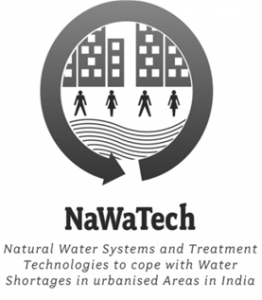Introduction
At present, urban settlements in developing countries are growing five times as fast as those in developed countries. As a consequence, today the urban population has exceeded the rural population of the world. In developing countries, urban population is predicted to grow from 1.9 billion in 2000 to 3.9 billion in 2030 (BROCKERHOFF 2000). India is projected to become the most populated country by 2030, with an estimated population of 2.53 billion inhabitants (CENSUS 2001). About 30 % of India’s people (almost 300 million) live in cities and towns generating over 60% of the country’s GDP and 90% of government revenues (IGOVERNMENT 2008). The rapid urbanisation and population growth and the lack of appropriate sanitation and wastewater treatment facilities result in water shortage, degradation of river, streams and aquifers and over exploitation of groundwater resources.
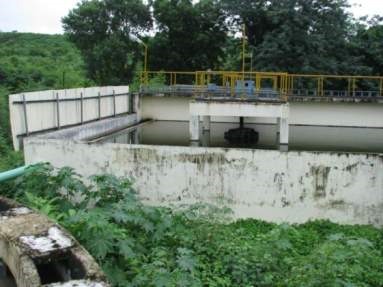
Collapsed activated sludge wastewater treatment plant in Pandharpur, Maharashtra Source: BARRETO DILLON 2010
It has been demonstrated that the conventional approach to water management has serious inefficiencies, such as providing high quality drinking water for all domestic purposes, large piping systems difficult to construct and maintain, large quantities of drinking water to transport human excreta, dependency of extensive energy supply for advanced treatment system, production of large quantities of sludge and loss of useful elements with the sludge (e.g. phosphorus). It is thus clear that current models of urban water management and their corresponding infrastructure have already failed or are on the verge of collapse from the perspective of cost-efficiency, performance and sustainability.
In order to optimise the operation, and maintenance and technically cost-effectiveness of future urban water management systems, there must be a shift of paradigm from an approach with centralised mixed end-of-pipe solutions to the design of integrated urban systems. Such systems should optimise water use and reuse, minimise operation and maintenance and be flexible.
Natural Water Systems and Compact Treatment as Solution
Facing the challenges of future urban water management, natural water treatment show a high potential due to their flexibility and adaptability, cost-efficiency, and low requirements for building, operation and maintenance and energy supply. Natural treatment systems refer to systems that use natural capacities in soil and vegetation to absorb and retain water, and to take-up, transform, or otherwise treat pollutants in water.
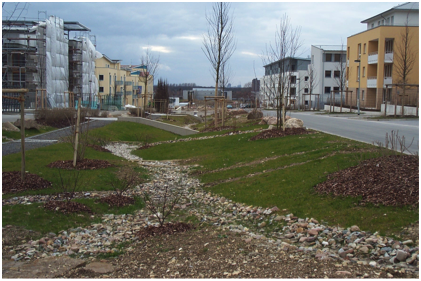
Natural system for managed stormwater collection, treatment and filtration in Switzerland Source: HEEB 2008
Natural systems are much more convenient than the conventional wastewater plants during the operational phase, because they require less energy than conventional systems. Limited mechanical devices are used in these systems thus reducing the maintenance costs. In addition it was found that natural systems are generally efficient for the removal of most of pollutants. Finally and most importantly these systems are found to be very reliable even in extreme operating conditions. They can better absorb a variety of both hydraulic and pollution shocks and have the capability to adapt to new, different, or changing requirements, hence making them more robust and resilient systems.
Natural treatments can be integrated in the urban scenario as flexible small-scale decentralised measures, such as infiltration devices or constructed wetlands for stormwater control and managed groundwater recharge. Thus, urban natural water treatment systems have a wide range of socio-economic and ecological services, including improved public amenity and health, flood retention capacity, groundwater recharge and drinking water supply.
In Europe, those systems have been developed for many years and their potential for the application in developing and newly-industrialised countries is widely accepted. However, the location of India and many developing and newly industrialised countries in warmer climatic zones sets different environmental conditions.
On the basis of a detailed inventory of natural treatment systems and compact treatment options, several promising axes have been identified:
- Wastewater and stormwater treatment and reuse for the managed aquifer recharge (MAR) (constructed wetland; SBRs & MBRs, soil aquifer treatment and aquifer storage and recovery);
- Stimulation of water retention and self-purification capacity of water resource via in-stream remediation using eco-hydrology principles;
- Improvement of surface water quality via bank filtration (lake or river bank filtration) for the generation (indirect) potable water;
- Secondary treatments for drinking water (sand filtration; membrane filtration; UV disinfection).
Previous experiences have shown that soil aquifer treatment (SAT) is a promising technology for the reclamation of stormwater and managed aquifer recharge. SAT technology involves infiltration of stormwater or secondary effluent (pre-treated wastewater) through a recharge basin with subsequent extraction through recovery wells, and embodies both treatment, dominant in the vadose (unsaturated) zone, and storage within the saturated zone (aquifer) (AMY & DREWES 2005). SAT in combination with both, advanced wastewater treatment system (e.g. activated sludge) or natural systems (e.g. constructed wetlands) has proven to be effective in many MAR sites (MELIN 2009; KAZNER 2009). However, little is known about the parameters controlling them and implementing man made technologies for enhancing those attenuation processes is not yet a common practice.
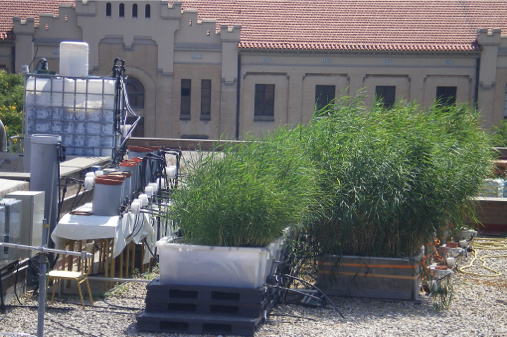
Prototype of an integrated black water system UASB followed by a hybrid wetland in Barcelona, Spain Source: UPC 2011
Constructed wetlands (CWs) are low cost eco-technological wastewater treatment systems that in the past 30 years have been set up all over the world as an alternative to conventional mechanical intensive systems for the treatment of a wide range of wastewaters like municipal, industrial, urban run-off, leachate, agricultural, etc. CWs can remove a variety of substances (organic matter, nutrients, microbiological contamination, micro-pollutants, etc.) and have been used worldwide for a large number of applications (GHERMANDI et al. 2007; ROUSSEAU et al. 2008; LLORENS et al. 2009; SEGUI et al. 2009) including as a pre-treatment step before artificial recharge of groundwater bodies in China (GROSSE et al. 1999; PERFLER et al. 1999). They have been shown to be adapted in particular to urban areas for the small-scale decentralised treatment and storage of stormwater as well as the treatment of greywater or blackwater prior to SAT.
Bank filtration (BF) consists in the abstraction of water from aquifers that are hydraulically connected to a surface water body, which is in most cases a river system. It is based on percolation of the surface water through the ground into the aquifer enhanced by the pumping in drinking water wells close to the riverbank. During the percolation processes potential contaminants from the surface water are removed by filtration, adsorption, reduction and biodegradation (RAY et al. 2002; TUFENKIJ et al. 2002; ORLIKOWSKI et al. 2006). The capacity of self-purification depends mainly on flow velocity, hydraulic residence time and the covered distance determined by the permeability and the hydraulic potential in the aquifer. In Central Europe, BF has been a traditional, efficient and well-accepted method of surface water treatment for more than 100 years for public and industrial water supply (GRISCHEK et al. 2002; SCHMIDT et al. 2003; SHARMA & AMY 2009). Due to the easy implementation and little maintenance, an effective removal of pathogens, solids and toxins of algae from surface water can be achieved. Because of its capacity to buffer shock loads and extreme climatic conditions (i.e. floods and droughts), BF has been suggested to be a useful drinking water treatment for developing and newly-industrialised countries.
For India situated in tropical, semi-arid and arid climates zones, little is known about the performance, operation and maintenance of natural water treatment and infiltration system. Especially the higher temperature and organic solid load in the water is a parameter expected to substantially affect the sorption and biodegradation process in soil filtration systems due to lower oxygen content in the water and thus changing redox conditions.
Sequencing Batch Reactors (SBR) and Membrane Bioreactors (MBR) represent intensive water treatment systems that are able to effectively treat heavily contaminated water sources as stand-alone systems or in combination to the above mentioned natural, extensive systems. SBRs are a variation of the well-known activated sludge system where the natural degradation and conversion processes of water bodies are utilised. In contrast to the natural treatment systems presented above, SBR and MBR are designed to concentrate biological degradation on a small footprint enabling high performance by control of the different biological treatment processes. The advantages of SBR and MBR over natural systems like e.g. constructed wetlands lie in contrast to increased efforts that are required for operation. Beside investments in technical equipment the active aeration and filtration (in the case of MBR) result in higher energy demands, hindering the application for financial reasons or simply because of lack of power supply in many regions of the world. The maintenance of membranes (cleaning and replacement) also leads to increased costs and efforts. Last but not least, both systems require sufficiently trained personnel for operation and maintenance.
As reaction to the main shortcomings of these technologies, research and development has been concentrated on reduced energy demands and lower maintenance requirements. Especially when it comes to the applicability for developing countries, adaptation is needed for applicability. Low energy membranes, hydrostatic filtration and simplified reactor designs as well as the combination to anaerobic treatment have been successfully applied in various projects. Having the various water related problems of India in mind (rapid urbanisation, high population density, contamination of surface and wastewaters with various toxic compounds) the implementation of adapted SBR and MBR treatment (or combined as SMBR) is a vital part of the NaWaTech concept. For NaWaTech the potential application of SBR and MBR covers and wide range: from decentralised treatment systems to components of the recharge chain. The possible reason for their inclusion can be demand for water re-use at high quality requirements in the urban context, the improvement of the pre-treatment for BF or SAT or the targeted removal of trace contaminants (micro pollutants) that would pass the other stages. MBR systems have wide applicability for municipal and industrial wastewater treatment but also for agriculture, food production and even for potable water treatment. Hence, in the scope of NaWaTech SBR and MBR are seen as complementary components of the natural systems to enlarge the modular flexibility.
The NaWaTech Concept
NaWaTech stands for “Natural Water systems and treatment Technologies to cope with water shortages in urbanised areas in India”. As an integrated approach, NaWaTech is based on the following axis:
- Interventions over the entire urban water cycle, which includes water sources, purification, distribution, use, collection, treatment and reuse.
- Optimisation of water use, by diminishing water use at home, reusing wastewater and preventing pollution of freshwater source;
- Prioritisation of small-scale natural and technical systems, which are flexible, cost-effective and require low operation and maintenance.
As shown in the Figure 2.5, the concept is based on optimised use of different urban water flows by treating each of these flows via a modular natural system taking into account the different nature and degree of pollution of the different water sources. Thus, it will cost-effectively improve the water quality of urban surface water and restore depleting groundwater sources.
Due to the multi-barrier approach, these systems are also able to treat heavily polluted water in order to reuse them and to supplement traditional sources to cope with water shortages today and in the future. The collected waters are treated in different steps by natural and technical processes at the surface or underground before they are reused to supply the urban population:
- Stormwater is collected and pre-treated in constructed wetland before being filtered through the soil and can be stored in the aquifer.
- Blackwater is treated anaerobically (producing energy and biogas) before being treated and collected in constructed wetlands together with or without the greywater. The effluent of these constructed wetlands will be either discharged to the surface water (if removal efficiency is satisfying) or reused for the urban agriculture or landscaping.
- Rainwater is collected on rooftops and either directly reused or fed into the aquifer.
- Surface water quality will be enhanced by in-stream and in-lake eco-hydrological systems prior to sub-surface passage and re-extraction for the urban water supply.
In addition to that, a low-cost and viable post-treatment option could be used based on different steps (sand filtration, low-pressure membrane filtration or UV disinfection) depending on the required quality for service or potable water.
A NaWaTech system is integrated as green infrastructure into the urban scene providing additional socio-economic benefits including flood absorption and buffering of seasonal variability in the availability of water, recreational values for the urban population, space for animals and plants and improved air quality.
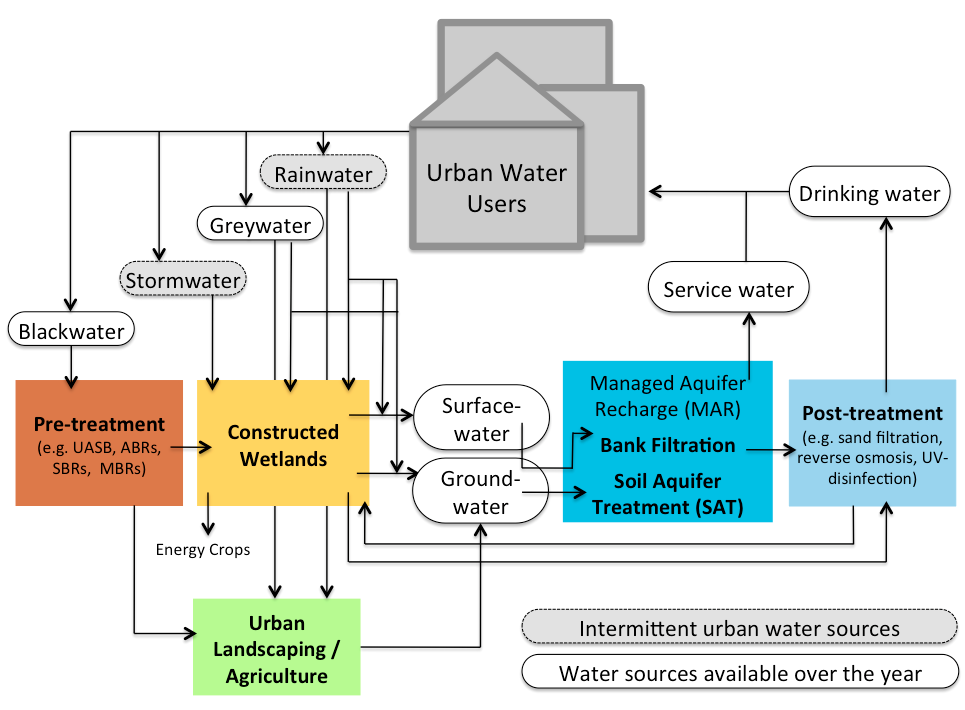
The NaWaTech approach: every available source is reused locally minimising the dependency from external freshwater sources and minimising the pollution of downstream water users.
This holistic approach minimises the urban water footprint and enhance the water security of the area, as the water cycle is closed at a local level. It also minimises the pollution of ecosystems and water sources for downstream users, as almost minimal amounts of freshwater get polluted and polluted water is treated and reused locally.
Soil Aquifer Treatment (SAT) as a Natural and Sustainable Wastewater Reclamation/Reuse Technology
Through the use of innovative analytical tools, the removal/transformation of wastewater effluent organic matter (EfOM) have been tracked through soil aquifer treatment (SAT).
AMY, G. ; DREWES, J. (2005): Soil Aquifer Treatment (SAT) as a Natural and Sustainable Wastewater Reclamation/Reuse Technology. Fate of Wastewater Effluent Organic Matter (EfOM) and Trace Organic Compounds. In: Environmental Monitoring and Assessment: Volume 129 , 19-26. URL [Accessed: 30.04.2015]An Urbanizing World
Article on the urbanization in developed and less developed countries.
BROCKERHOFF, M.P. ; KENT, M.M. (2000): An Urbanizing World. In: Population Bulletin : Volume 55 , 1-45. URL [Accessed: 30.04.2015]Census Data, India at a Glance - Population
Website with information on the population in India.
CENSUS (2001): Census Data, India at a Glance - Population. New Delhi: The Registar General & Census Commissioner, India URL [Accessed: 09.09.2010]Constructed Wetlands: the ugly Duckling of Water Recycling?
Andrea Ghermandi, Davide Bixio and Pietro Traverso review the performance of constructed wetlands in light of the revised WHO guidelines for the safe use of wastewater in agriculture.
GHERMANDI, A. ; BIXIO, D. ; TRAVERSO, P. (2007): Constructed Wetlands: the ugly Duckling of Water Recycling?. In: Water21: Volume 9 , 49-51. URL [Accessed: 30.04.2015]Siting and Design Issues for Riverbank Filtration Schemes
Chapter about the use of Riverbank Filtration Systems.
GRISCHEK, T. SCHOENHEINZ, D. RAY, C. (2002): Siting and Design Issues for Riverbank Filtration Schemes. In: RAY, C. ; MELIN, G. ; LINSKY, R.B. (2002): Riverbank Filtration. Improving Source-Water Quality. Dordrecht: 291-302. URL [Accessed: 30.04.2015]Biotechnological Approach to Water Quality Improvement in Tropical and Subtropical Areas for Reuse and Rehabilitation of Aquatic Ecosystems
Urban India to Contribute 70% of GDP by 2011
Article about urbanization in India and the impact on GDP.
IGOVERNMENT (2008): Urban India to Contribute 70% of GDP by 2011. New Delhi: IGovernment URL [Accessed: 12.12.2009]TECHNEAU - a Collective Effort Towards Safe Water Supply
Introduction into the TECHNEAU project with some focus on the challenges the water sector is facing and how the project addresses these challenges. Among these challenges are climate change, continued population growth and urbanisation, emerging contaminants, aging infrastructure, an increasing shortage of good quality and readily treatable resources and more demanding regulators and consumers.
KAZNER, C. (2009): TECHNEAU - a Collective Effort Towards Safe Water Supply. In: VAN DEN HOVEN, T. (2009): TECHNEAU - Safe Drinking Water from Source to Tap. State of the Art & Perspectives. London: . URL [Accessed: 30.04.2015]Water Quality Improvement in a Full-Scale Tertiary Constructed Wetland
Article about the surface flow constructed wetland (SF CW) in Can Cabanyes (Granollers, Catalonia, northeastern Spain) which was created as a part of a series of activities aimed at restoring a highly impacted fluvial peri-urban zone.
LLORENS, E. ; MATAMOROS, V. ; DOMINGO, V. ; BAYONA, J.M. ; GARCIA, J. (2009): Water Quality Improvement in a Full-Scale Tertiary Constructed Wetland. Effects on Conventional and Specific Organic Contaminants. In: Science of the Total Environment: Volume 407 , 2517-2524. URL [Accessed: 30.04.2015]Reclaim Water. Water Reclamation Technologies for Safe Artificial Groundwater Recharge. Publishable Final Activity Report
This report presents results from eight technical pilot studies on aquifer recharge (including SAT) between 2005 and 2008 on five continents. The main objective of these studies was to assess the overall performance of these sites in recharging aquifers mainly for irrigation and potable water supply purposes by following contaminant fate throughout each scheme.
MELIN, T. (2009): Reclaim Water. Water Reclamation Technologies for Safe Artificial Groundwater Recharge. Publishable Final Activity Report. Aachen: RWTH Aachen University URL [Accessed: 26.05.2019]The Impact of River Water on Groundwater Quality in an Urban Floodplain Area, the Lobau in Vienna
The main focus of this work is on processes affecting groundwater quality in the Lobau. Therefore, the relationship between groundwater quality and the distance to the main-channel and the respective water level is analysed by multivariate statistics. A general characterization is done by a Principal Component Analysis, based on chemical water quality data of six groundwater monitoring stations in the period between 1992 and 2005.
ORLIKOWSKI, D. WEIGELHOFER, G. (2006): The Impact of River Water on Groundwater Quality in an Urban Floodplain Area, the Lobau in Vienna. (= Proceedings 36th International Conference of IAD ). Vienna: Austrian Committee Danube Research URL [Accessed: 30.04.2015]Constructed Wetlands for Rehabilitation and Reuse of Surface Waters in Tropical and Subtropical Areas
Results from small-scale plots of constructed wetlands in Europe and China.
PERFLER, R. ; LABER, J. ; LANGERGRABER, G. ; HABERL, R. (1999): Constructed Wetlands for Rehabilitation and Reuse of Surface Waters in Tropical and Subtropical Areas. First Results from Small-Scale Plots using Vertical Flow Beds. In: Water Science and Technology : Volume 40 , 155-162. URL [Accessed: 11.05.2015]Riverbank Filtration
The purpose of this book is to show that riverbank filtration (RBF) isa low-cost and efficient alternative water treatment for drinking-water applications.
RAY, C. ; MELIN, G. ; LINSKY, R.B. (2002): Riverbank Filtration. Improving Source-Water Quality. (= Water Science and Technology Library , 43 ). Dordrecht: Springer Netherlands URL [Accessed: 30.04.2015]Constructed Wetlands for Water Reclamation
Constructed wetlands have been increasingly used throughout the world for secondary and especially for tertiary treatment of wastewater and stormwater. If well designed and maintained, their effluents can meet the high standards required for reclaiming the water. One can also partially reclaim nutrients by harvesting the aquatic vegetation or by combining wastewater treatment with aquaculture. Constructed wetlands further provide certain ancillary benefits such as wildlife habitat function, recreational facilities etc. This paper gives an overview of treatment performances and consequent reuse possibilities, operation and maintenance requirements, costs and constraints interfering with the application of this technology.
ROUSSEAU, D.P.L. ; LESAGE, E. ; STORY, P.A. ; VANROLLEGHEM, P. ; DE PAUW, N. (2008): Constructed Wetlands for Water Reclamation. In: Desalination: Volume 218 , 181-189. URL [Accessed: 30.04.2015]Techno-Economical Evaluation of Water Reuse for Wetland Restauration: a Case Study in a Natural Park in Catalonia, Northeastern Spain
The main interest of the methodology for the investigation of wastewater reclamation and reuse systems which is proposed in this paper is that all costs and benefits (social and private) are considered in the economic and technological analysis. This general concern allows an improvement in the design of investment decisions. Traditionally, an economic-financial analysis of wastewater reclamation and reuse systems focuses exclusively on the study of costs and private benefits. The methodology that is presented in this paper takes into account not only the private impacts but also the project spillovers which could have relevance on the project. In this research, the use value of the reclaimed water in the Natural Wildlife Park of Aiguamolls de l’Empordà is estimated. The travel cost technique is applied to estimate the external value of the Park. According to the final results, the price of the reclaimed water in the Park should have to be between 0.75 €/m3 (without opportunity cost) and 1.20 €/m3 (with opportunity cost).
SEGUI, L. ; ALFRANCA, O. ; GARCIA, J. (2009): Techno-Economical Evaluation of Water Reuse for Wetland Restauration: a Case Study in a Natural Park in Catalonia, Northeastern Spain. In: Desalination : Volume 246 , 179-189. URL [Accessed: 30.04.2015]Bank Filtration – A Sustainable Water Treatment Technology for Developing Countries
Based on the results of two feasibility studies conducted in Malawi and Kenya, this paper explains the potentials and constraints of promoting the bank filtration technology for water treatment in developing countries.
SHARMA, S.K. AMY, G. (2009): Bank Filtration – A Sustainable Water Treatment Technology for Developing Countries. (= 24th WEDC International Conference, Addis Ababa, Ethiopia ). Delft: UNESCO-IHE URL [Accessed: 24.08.2011]The Promise of Bank Filtration
Article about bank filtration and its use.
TUFENKIJ, N. ; RYAN, J.N. ; ELIMELECH, M. (2002): The Promise of Bank Filtration. A Simple Technology May Inexpensively Clean Up Poor-Quality Raw Surface Water. In: Environmental Science and Technology: Volume 1 , 423-428. URL [Accessed: 30.04.2015]

